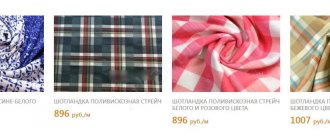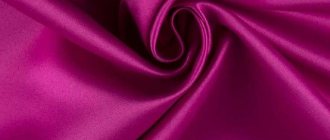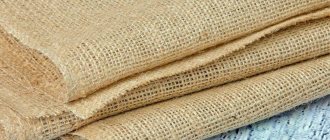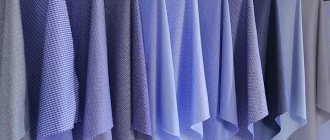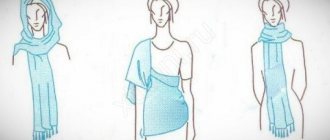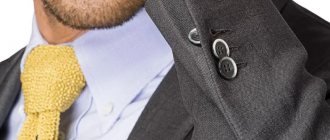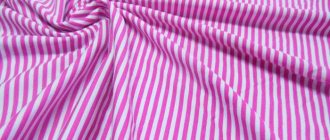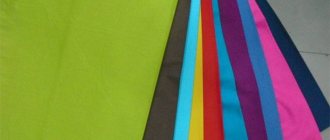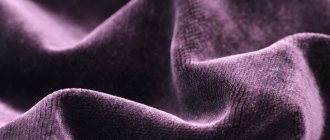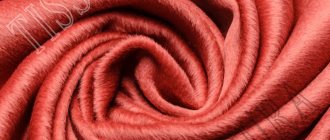Translated from English, the word moleskin means “mole skin”. And, indeed, this name well describes the appearance of moleskine. It is a dense, dark fabric with a glossy sheen.
The material was invented in Great Britain at the beginning of the 20th century, initially used for the production of workwear, and then in other areas of industry. In Russia, the fabric is sometimes called “devil's leather.”
Description of the composition and production process of moleskine
Moleskine is 100% cotton fabric. According to Russian GOST R57877-2017, the inclusion of synthetic fibers is not allowed in its composition. However, foreign companies also produce mixed versions of the material.
The production process includes the following steps:
- Cotton is harvested manually or mechanized.
- The raw materials are kept in storage for a day, then loosened and cleaned of foreign impurities.
- The resulting fibers are twisted and pressed to form thin threads.
- The material is painted. Most manufacturers use dark colors: black, gray, khaki, olive, blue. Bleached fibers and camouflage patterns (flektarn) are also common.
- The threads are woven using the satin method, in which additional overlaps are included in the fabric, reinforcing the bonds between the warp and weft. The result is a very dense fabric.
If the material is intended for sewing workwear, then an additional impregnation is applied to its surface: insulating, water-repellent or fire-resistant. And some manufacturers subject the reverse side of the product to napping to give it greater softness.
Features of the material
Moleskine is a fabric made from cotton with a reinforced, super-dense satin weave. At the same time, overlaps are added to the fabric, strengthening the connections between the warp and weft threads. The material acquires special qualities.
- Strength and high wear resistance.
- The polished smoothness is caused by the long overlaps of the weft threads.
- Dust resistance, which is much higher than other materials.
- Easy to clean from radioactive, chemical and biological contaminants. The fabric meets all requirements for decontamination materials.
- Convenience and comfort to wear is explained by environmentally friendly natural raw materials. Cotton does not create a greenhouse effect; it allows the body to breathe, removes excess moisture, and does not accumulate static electricity.
Some disadvantages of the fabric include increased flowability caused by the rigidity and smoothness of the threads, as well as the ability to be cut by a needle when sewing, which is explained by the high density of the material.
Types of Moleskine
Different types of material may have differences in composition and performance characteristics. The table below shows the fabrics that are commercially available.
Table 1. Types of moleskine
| Name | Characteristics | Areas of application |
| S174-SOUTH or S27-UD | Density 250 g/m², additional impregnation for protection against aggressive acids, alkalis, and liquid metal particles | Sewing workwear for workers in the chemical and automotive industries, metallurgy |
| S159-SOUTH or S28-UD | Density 280 g/m², fire-resistant fabric | Sewing workwear for employees of the Ministry of Emergency Situations and other areas related to fire risk |
| S173-SOUTH or S26-UD | Density 347 g/m², increased dust resistance | Sewing workwear for workers of nuclear power plants, public utilities, and the military |
There is another classification: P25 and P29. The first standard means protection from fine dust, the second means fire-resistant and water-resistant impregnation.
Varieties of matter
Depending on the density of the fabric and the impregnations used for processing, moleskin is divided into several types. The most popular and in demand are the following brands.
S173-SOUTH. The fabric of this brand has a density of 250 g/m² and is designed for the manufacture of special clothing for workers in cement, asbestos, and flour mills.
N174-SOUTH. This type of moleskine also has a surface density of 250 g/m². Thanks to special treatment, the fabric reliably protects against the effects of acids with a concentration of no more than 20% and other contaminants.
S159-SOUTH. The fabric density on the surface is 280 g/m². This type of moleskin has a fire-resistant impregnation and is used for the manufacture of work clothes that can protect against fire and ultra-high temperatures.
Main characteristics of moleskin fabric
Like any fabric, moleskin has its advantages and disadvantages. The positive performance characteristics of the material include the following:
- Increased strength . Due to the reinforced satin weave of the threads, moleskin is very difficult to tear.
- Abrasion resistance . According to GOST R57877-2017, moleskin can withstand 2000 friction cycles. Adding a protective impregnation to the composition increases this figure several times. In comparison, regular plain weave cotton fabric will deteriorate after just 1,500 abrasion cycles.
- Dustproof . The material reliably protects the skin from pollution, and some of its varieties from radioactive dust. Since debris does not penetrate deep into the fibers, the fabric is easy to clean and wash.
- Air permeability . This advantage is typical for most natural materials. In cotton clothes, the body “breathes” and a person feels comfortable.
- Hygroscopicity . The fabric absorbs moisture well. This property is important for those who engage in intense exercise and sweat.
- Beautiful appearance . Although the fabric is inexpensive to produce, it looks stylish. Original colors, shapes and glossy shine give moleskin clothing a “zest”.
- Heat resistance . P29 standard material protects the skin from temperature changes and open fire. In addition, the product can be washed in hot water.
- Safety . Cotton is a hypoallergenic material. However, items made from it should be stored in a dry place to prevent the growth of mold.
Moleskine has the same disadvantages as most types of cotton fabrics. During processing it has increased flowability, and when washed it shrinks. In addition, the material is quite hard. It may chafe sensitive skin, especially in the elbow and shoulder areas.
History of production and use
Moleskin fabric appeared in Russia in the 19th century. Until this time, the production process was carried out only in England. Excessively dense versions of the material had a specific name - “devil's skin”. After its appearance on the market, textiles were used to create special and military uniforms, and also as a basis for artificial leather. Therefore, moleskine was often used to make book bindings and shoe uppers.
You might be interested in Bengalin features: properties and characteristics of the material
The production of moleskin material is made from thick cotton fabric. This is done using reinforced satin weaving. Its essence lies in the fact that additional overlaps are intertwined between the two warp and weft threads.
S159-SOUTH
Until the 50s of the 20th century, the “devil's skin” fabric was only one shade; later it began to be dyed in rich shades and used for sewing ski clothes. In those days, this was an ideal option, since moleskin retained heat and prevented the penetration of moisture. But with the advent of synthetic membrane fabrics, the popularity of “devil’s skin” began to rapidly decline. This was explained by its high hygroscopicity, which prevented the removal of moisture from the body. That is why in the modern world sportswear is not made from this fabric. But this did not stop Moleskine from gaining immense popularity around the world.
Modern moleskine differs significantly from its original. Now during production, thinner, ultra-strong threads are used together with synthetic fibers. Special solutions with which the finished product is impregnated make it as safe as possible. Among other things, modern material is created taking into account the fact that clothing made from it will subsequently be used in difficult production conditions.
Thanks to the versatility of textiles, not only winter clothes are made from it, but also summer ones. The reasonable price makes it accessible and in demand among buyers.
Moleskin fabric with trim
In what areas is moleskin used?
The main area of application of the material is the production of workwear. Suits are made from moleskin for the following workers:
- nuclear power plants;
- metallurgical enterprises;
- utilities;
- law enforcement agencies: military, internal affairs bodies, Ministry of Emergency Situations;
- oil and gas and automotive industries;
- medical institutions;
- aviation;
- agriculture, forestry, fishing.
Less dense types of fabric are used to make stylish clothes: jackets, jackets, trousers, suits, jackets, raincoats. Moleskin with water-repellent impregnation is used in sewing raincoats, travel equipment, and car covers. In addition, the practical material can be used as a base for artificial leather, book binding, and notepad cover.
What is made from moleskine?
The first use of this material was work clothing for those who have to work in conditions of high concentrations of dust, open fire, and all kinds of pollution. “Devil's skin” became widely known at the beginning of the last century. With the advent of such technical innovations as the automobile and the airplane, overalls made of “damn leather” began to be associated with the romantic professions of pilots and drivers, and the fashionable fabric was also used to sew ordinary clothes, especially for teenagers and young people.
As practice has shown, the ultra-dense weaving of moleskin fibers is an ideal filter for various types of microparticles, which is why it is widely used for various types of protective clothing. In addition, a special fire-resistant and fire-retardant material has been developed.
- For enterprises with high dust levels (cement factories, flour mills, etc.), moleskin is used, the density of which is 324 g/sq.m (grade S26-UD).
- For chemical plants and when working with acids, they use the S27-YUD grade with acid-resistant impregnation, the density of which is 250 g/sq.m.
- To work in open flame conditions, you need fire-resistant moleskin S28-UD, which can withstand an open flame for half a minute.
This material is also used for various filters, the manufacture of artificial leather and in bookbinding.
How to properly care for moleskin products
The fabric is easy to care for. However, to extend the life of products made from it, it is useful to follow the following rules:
- Wash things at a temperature of 40-60°C. Clothes will shrink in hotter water. Washing by hand or in an automatic machine at medium speed is allowed.
- Products with protective impregnation are recommended to be washed with liquid detergents for delicate fabrics. Other types of material are used as ordinary powder. Do not use bleach.
- Dry items vertically, away from the radiator. You can hang them in the sun. Machine drying is not recommended as it can cause shrinkage.
- Iron items with an iron at 150°C or a steamer.
Items can be dry cleaned. It is better to store them folded on the shelves of the closet.
Scope of application: what is sewn from fabric
Used primarily for sewing various clothes:
- Military clothing in khaki color (khaki, urban camouflage, etc.).
- Workwear with or without protective impregnation for various industries (mainly for “dirty” areas).
- Simple home clothes - shorts, pants, T-shirts, vests, jackets and so on.
- Inserts for reinforced sports shoes.
- Canvas and moleskin are used to make bags, thick bindings for books and documents, and covers for technical equipment (building materials, industrial electronics, and so on).
Used for sewing protective clothing for firefighters, rescuers and doctors.
Buying moleskin fabric: FAQ
Question. How much does moleskin cost?
Answer. The average price of 1 linear meter of fabric with a density of 250 g/m² (the most common type) is 150-300 rubles.
Question. Which companies produce workwear made from moleskin?
Answer. Nowadays in Russia, items on sale are mainly from domestic and Chinese companies. Good, “Vostok-Service”, “Leon-working clothes”, “Ivspetsposhiv”, Ursus.
Moleskine is a durable, wear-resistant and practical fabric. It can be used by both workers in hazardous industries and ordinary people who want to wear comfortable things. With proper care, clothing will last for many years.
Properties and characteristics
Increased fiber density is considered the main characteristic of moleskin material. This feature makes it possible for clothing made from this textile to provide reliable protection of the human body from all kinds of contaminants.
Important! Thanks to the special stylistic weave of the threads, the surface of the finished product is very smooth. It ensures that large particles roll off the front side of the suits. Moleskin fabric can also be impregnated with different compounds to impart special properties and performance.
On the reverse side the material has a slight fleece. It is created due to the tufting of the finished fabric. The fibers of individual threads are pulled out onto the surface of the textile. It is this feature that improves the heat-shielding properties and increases the wear resistance of the product, and also makes the reverse side softer.
Moleskine Blend collection
Moleskine is most often a plain-dyed fabric of one color that does not fade for a long time, wears out little and does not lose its shape at all. Unfortunately, not everyone knows what moleskine is. Some people think that such dense material does not allow the body to breathe. This opinion is erroneous, since it has a cotton base, thanks to which the suit will not be hot even in rooms with high temperatures.
You might be interested in what is twill satin: description of the fabric and differences from satin
"Devil's Skin" has the following unique properties:
- ease of care;
- environmental friendliness;
- high wear resistance;
- mechanical strength;
- dustproof.
Moleskine Blend canvas
Compound
Moleskin material is made from cotton fibers. The high density and strength of the fabric is achieved through reinforced satin weave. During the production process, special overlaps are added to the warp and weft threads. Moleskin is a purely cotton fabric; it is unacceptable to include other fibers in its composition. The material must comply with GOST R 57877-2017.
Satin weave diagram and graph
There are separate GOST standards for workwear made from moleskin: heat-resistant suits must comply with GOST R 12.4.297-2013. The standard defines the technical characteristics of products and their test methods. So, to test fire resistance, the fabrics are exposed to an open flame for 30 seconds.
